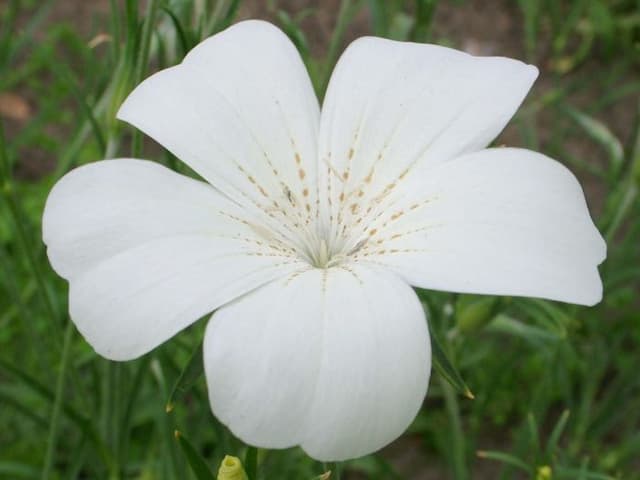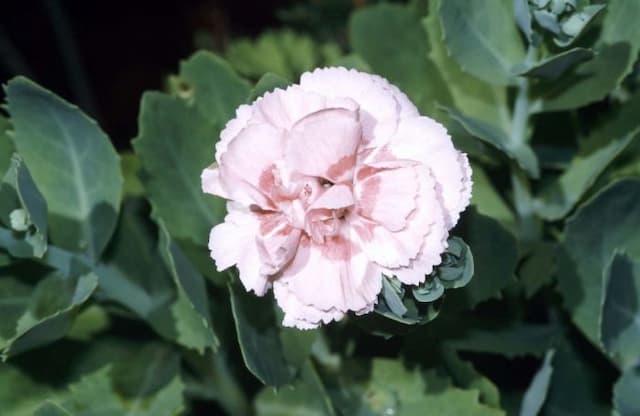Maltese Cross Lychnis chalcedonica

ABOUT
Commonly known as Maltese Cross, Lychnis chalcedonica boasts a striking appearance with its vibrant flowers and lush foliage. The plant produces a profusion of intensely bright red blooms that are distinctly shaped; each flower is composed of five petals that are deeply notched, almost forming a cross, which is how it earned its common name. These eye-catching flowers are grouped together in dense, flat-topped clusters at the top of upright stems that are leafy and provide a contrasting green backdrop to the fiery floral display. The leaves of Maltese Cross are lance-shaped, with a slightly hairy and textured surface, adding to the visual interest of the plant. These leaves form a clump at the base of the stems and partially ascend along the stem itself, embracing it snugly. The overall look of the plant is one of both robustness and brightness, with its radiant flower clusters creating a focal point in any garden setting. Maltese Cross is celebrated for its showy flowers that have the power to attract butterflies and other pollinators, playing a role in the local ecosystem while beautifying the landscape.
About this plant
 Names
NamesFamily
Caryophyllaceae
Synonyms
Maltese Cross, Jerusalem Cross, Scarlet Lychnis, Burning Love, Flower of Bristol, Nonesuch, Gardener's Delight
Common names
Silene chalcedonica, Coronaria chalcedonica.
 Toxicity
ToxicityTo humans
Maltese Cross is not widely recognized for being toxic to humans. However, as with any plant, individual allergies may exist. If any part of Maltese Cross is ingested and symptoms of a negative reaction occur, such as gastrointestinal distress or an allergic response, medical attention should be sought.
To pets
Maltese Cross is not typically known for being toxic to pets. Nevertheless, ingestion of non-food plants can sometimes cause mild stomach upset in animals. If your pet consumes any part of this plant and exhibits signs of distress such as vomiting, diarrhea, or unusual behavior, consult your veterinarian.
 Characteristics
CharacteristicsLife cycle
Perennials
Foliage type
Deciduous
Color of leaves
Green
Flower color
Red
Height
2-3 feet (60-90 cm)
Spread
1-2 feet (30-60 cm)
Plant type
Herb
Hardiness zones
3
Native area
Russia
Benefits
 General Benefits
General Benefits- Attracts pollinators: Lychnis chalcedonica, commonly known as Maltese Cross, is favored by bees, butterflies, and other pollinators, enriching the ecosystem.
- Low maintenance: Maltese Cross is known for its hardiness and ability to thrive with minimal care, making it an excellent choice for novice gardeners.
- Drought tolerance: Once established, this plant has a good tolerance for dry conditions, requiring less watering compared to some other garden plants.
- Ornamental appeal: The bright, eye-catching red flowers of Maltese Cross add vivid color to gardens, borders, and floral arrangements.
- Seasonal interest: Blooming in early to midsummer, it provides interest during a time when many other plants may not be in their prime.
- Cultivation versatility: This plant can be grown in a variety of soil types, from loam to clay, as long as the soil is well-drained.
- Resistant to pests: Maltese Cross is generally resistant to many common pests, reducing the need for chemical treatments in the garden.
- Cold hardiness: It is suitable for growing in cooler climates, as it can withstand cold temperatures once it is established.
- Propagation ease: Gardeners can easily propagate Maltese Cross by seed, division, or cuttings, allowing them to expand their garden or share with others.
- Historical interest: With a name that references the symbol of the Knights of Malta, this plant adds historical and cultural context to a garden setting.
 Medical Properties
Medical PropertiesThis plant is not used for medical purposes.
 Air-purifying Qualities
Air-purifying QualitiesThis plant is not specifically known for air purifying qualities.
 Other Uses
Other Uses- Lychnis chalcedonica, commonly known as Maltese cross, can be used as a natural dye for fabrics, imparting a range of orange, red, or yellow hues depending on the mordant used.
- Due to its striking color and shape, the Maltese cross is often used in garden design as a symbolic element in religious or historical-themed gardens.
- Maltese Cross flowers can be pressed and used in botanical artwork or herbarium collections as a way to preserve their unique geometric form and color.
- The dried seed heads of the Maltese cross can be used in flower arrangements and bouquets, adding an interesting texture and form that persists through winter.
- In educational settings, the Maltese cross can be used to illustrate the concept of bilateral symmetry in biology class demonstrations or botanical studies.
- The plant is sometimes incorporated into butterfly gardens as it provides nectar for pollinators like butterflies and bees.
- Maltese cross is used as a companion plant in vegetable gardens, where it is believed to attract beneficial insects that prey on pests.
- Crafters use the vibrant petals of the Maltese cross in creating natural confetti for weddings or other celebratory events, as it is biodegradable and environmentally friendly.
- The Maltese cross can serve as an indicator plant for gardeners, as its need for watering tends to reflect the needs of other plants in the vicinity.
- Some gardeners use the structure of the Maltese cross to support smaller adjacent plants, leveraging its sturdy stems to prop up plants that are prone to drooping.
Interesting Facts
 Feng Shui
Feng ShuiThe Maltese Cross is not used in Feng Shui practice.
 Zodiac Sign Compitability
Zodiac Sign CompitabilityThe Maltese Cross is not used in astrology practice.
 Plant Symbolism
Plant Symbolism- Protection: Often grown in gardens and used in olden times to ward off witchcraft and evil spirits.
- Christian Symbolism: Sometimes called Burning Love or Flower of Bristol, its bright red color is associated with the Pentecost, symbolizing the tongues of fire that appeared over the heads of the apostles.
- Love and Affection: The warm, fiery colors of the Flower of Bristol are associated with strong emotions, hence the nickname "Burning Love."
 Water
WaterKnown commonly as Maltese Cross, it should be watered thoroughly, allowing the soil to dry out slightly between waterings. This usually means providing about 1 inch of water per week, but this can vary based on climate conditions, soil type, and plant size. It's important to avoid overwatering, so always check the soil moisture before adding more water. During prolonged dry spells or hot weather, additional water may be necessary to keep the soil evenly moist but not soggy.
 Light
LightMaltese Cross thrives in full sun to partial shade conditions. It prefers to be placed in a spot where it can receive at least 6 hours of direct sunlight daily. Too little light can lead to spindly growth and fewer flowers, so aim to plant it in an area where it will have ample access to bright light without being shaded by larger plants or structures.
 Temperature
TemperatureMaltese Cross is hardy and can tolerate temperatures down to -30 degrees Fahrenheit and high temperatures well above 100 degrees Fahrenheit. The plant's ideal growing temperatures range between 60 to 75 degrees Fahrenheit. It is a robust plant that adapts to various climate conditions but should be protected from extreme cold when first planted or if it is particularly fragile.
 Pruning
PruningMaltese Cross should be pruned to remove spent flowers and encourage additional blooming throughout the season. Pruning can also help maintain the plant's shape and prevent it from becoming too leggy. Cut back the stems after the first bloom in late summer to promote a second bloom period. It is also advisable to prune the plant down to the ground in late fall after the foliage has died back.
 Cleaning
CleaningAs needed
 Soil
SoilThe best soil mix for Lychnis chalcedonica, commonly known as Maltese Cross, should be well-draining and fertile with a neutral to slightly alkaline pH of 6.5 to 7.5. A blend consisting of garden soil, compost, and a portion of perlite or sand will promote healthy growth. Adding organic matter annually will enrich the soil quality.
 Repotting
RepottingMaltese Cross does not require frequent repotting as it is a hardy perennial. It should be lifted and divided every 3-4 years to maintain vigor and to prevent overcrowding. When repotting, ensure to provide fresh soil mix with adequate nutrients.
 Humidity & Misting
Humidity & MistingMaltese Cross is tolerant of a wide range of humidity levels and does well in outdoor garden settings where the humidity is naturally regulated by the environment. They do not have specific humidity requirements, making them versatile for varying climates.
 Suitable locations
Suitable locationsIndoor
Ensure good light, moderate watering, and well-drained soil.
Outdoor
Plant in sun, well-draining soil, divide every 3-4 years.
Hardiness zone
3-9 USDA.
 Life cycle
Life cycleMaltese cross (Lychnis chalcedonica) starts its life cycle from a seed that germinates in spring, under suitable temperature and moisture conditions. Once the seedling emerges, it develops into a rosette of basal leaves and, given proper conditions, will grow into a mature plant. This perennial plant typically experiences a vegetative growth stage where it establishes a robust root system and abundant foliage. By early to mid-summer, it enters the flowering stage, producing clusters of brilliant scarlet flowers that attract pollinators and result in seed set. After flowering, seeds can be collected or left to self-sow, allowing the plant to propagate naturally. As the growing season ends, the Maltese cross becomes dormant, with above-ground parts dying back in winter, but it can re-emerge from its rootstock with the arrival of the next spring.
 Propogation
PropogationPropogation time
Spring-Early Summer
Propogation: The Maltese Cross, known scientifically as Lychnis chalcedonica, is commonly propagated through seed sowing. The best time to sow the seeds is in spring, after the risk of frost has passed, although sowing can also be successfully done in autumn in warmer climates. The most popular method involves surface-sowing the seeds onto well-draining soil, ensuring they are not covered as they require light to germinate. Water the seeds gently to keep the soil moist and place the container in a location with plenty of indirect sunlight. Germination usually occurs within two to three weeks at a temperature around 70 degrees Fahrenheit (21 degrees Celsius). Once the seedlings have developed a couple of true leaves, they can be thinned out and eventually transplanted to their final position in the garden, spacing them about 12 inches (30 centimeters) apart to accommodate their mature size.








![Pink [Bubblegum]](/_next/image?url=https%3A%2F%2Fplants-admin.emdemapps.com%2Fimages%2Fplants%2F%2Fimages%2F604b596f31cbb.png&w=640&q=75)
